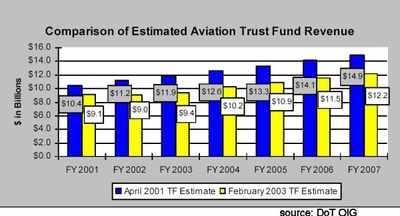Hey, Big Spender!
 The Department of Transportation's Office
of Inspector General released a report on the FAA yesterday, and
it's not flattering to that agency's top management. We're
presenting a few excerpts here; if you'd like to really get a
snootful, have a look at the link at the bottom.
The Department of Transportation's Office
of Inspector General released a report on the FAA yesterday, and
it's not flattering to that agency's top management. We're
presenting a few excerpts here; if you'd like to really get a
snootful, have a look at the link at the bottom.
The report explained, "In 1996, Congress acted to make FAA a
performance-based organization by giving the Agency two powerful
tools -- personnel reform and acquisition reform.
"The expectation was that, by being relieved of Government
personnel and procurement rules, FAA would operate more like a
business -- that is, services would be provided to users
cost-effectively, and air traffic control modernization programs
would be delivered approximately on time and within budget."
However, "Seven years later, FAA's budget has grown from $8.2
billion in FY 1996 to $14 billion in FY 2004 -- an increase of $5.8
billion, or over 70 percent. About half of that increase was
attributable to FAA's operating budget. During this period, we have
also seen large cost overruns and schedule slips in FAA's major
acquisitions."

Three areas are sinkholes:
 The FAA was released
from most government personnel policies. The result? "To date, the
most visible results of personnel reform are increased workforce
costs."
The FAA was released
from most government personnel policies. The result? "To date, the
most visible results of personnel reform are increased workforce
costs."
If you're an FAA employee, did you see it? Operating
costs (mostly payroll) went, "...from $4.6 billion in FY 1996 to
$7.6 billion in FY 2004, an increase of over 65 percent."
Maybe you saw it, if you're a controller. The report
continues, "The new pay system for controllers was a significant
cost driver. Between 1998
(when the new system was implemented) and
2003, the average base pay for controllers increased from $72,000
to over $106,000 -- a 47 percent increase. This compares to an
average salary increase for all other FAA employees during the same
period of about 32 percent." Oh -- and, "...only about 36 percent
of FAA employees receive pay increases based on individual
performance."
Sweetheart deals -- don't you have one? The
OIG continued, "We also found that there are somewhere
between 1,000 and 1,500 side bar agreements... that FAA managers
entered into." The FAA can't tell exactly how big a deal that is.
"Despite the cost implications, at the time of our review FAA
management did not know the exact number or nature of these
agreements, there were no established procedures for approving
[them], and their cost impact on the budget had not been
analyzed."
Maybe it'll turn around, now...
 Improvement seems
possible, though. The OIG, "...briefed the FAA Administrator about
our concerns in January 2003 -- 2 months after initiating this
review. FAA has moved expeditiously to address this issue,
including identifying those MOUs that are problematic or costly and
opening discussions with NATCA to reopen several agreements."
Improvement seems
possible, though. The OIG, "...briefed the FAA Administrator about
our concerns in January 2003 -- 2 months after initiating this
review. FAA has moved expeditiously to address this issue,
including identifying those MOUs that are problematic or costly and
opening discussions with NATCA to reopen several agreements."
Ignoring Congress
The report continued, "In 1996, Congress also
directed FAA to have a fully-functioning cost accounting system...
Now, after nearly 7 years of development and over $38 million, FAA
still does not have an adequate cost accounting system, and
it expects to spend at least another $7 million to deploy the cost
accounting system throughout FAA." The Inspector General seems to
say it's not the FAA's fault, though: Congress
only wanted to sound tough: "In our opinion, the principle reason
that FAA does not have an effective cost accounting system is
because it has not experienced any consequences for not having
one."
OIG Recommends Cuts in Systems:
How to save money? The Inspector General has some
ideas: "...we estimate FAA could realize cost savings of nearly
$500 million over 7 years by reducing the number of existing
automated flight service stations by over half in conjunction with
deployment of new flight service software. We also identified
that FAA could save over $57 million annually by expanding the
contract tower program to 71 visual flight rule towers still
operated by FAA..."
Sloppy management practice extends beyond
people-management:
 On a roll, the OIG report
writer had more to say: "We found that cost growth, schedule
delays, and performance problems continue with FAA's major
acquisitions. Overall, the 20 projects we reviewed have experienced
cost growth of about $4.3 billion (from $6.8 billion to $11.1
billion) and schedule slips of 1 to 7 years." It warns,
"Billion-dollar cost growth with acquisitions is not sustainable or
affordable in light of declining Trust Fund revenues."
On a roll, the OIG report
writer had more to say: "We found that cost growth, schedule
delays, and performance problems continue with FAA's major
acquisitions. Overall, the 20 projects we reviewed have experienced
cost growth of about $4.3 billion (from $6.8 billion to $11.1
billion) and schedule slips of 1 to 7 years." It warns,
"Billion-dollar cost growth with acquisitions is not sustainable or
affordable in light of declining Trust Fund revenues."
What do they really think?
- "Our work has also found that FAA has not followed
sound business practices for administering contracts. We have
consistently found a lack of basic contract administration at every
stage of contract management...
- "We also found that FAA's Workers' Compensation Program
continues to be subject to fraud and abuse, in terms of both
stress-related claims and long-term injury claims." They found, for
example, "...218 claimants still receiving workers' compensation
benefits who were 80 years old or older."
- "FAA needs to remain vigilant in its oversight of airport
revenue diversions. ...we continue to find cases of airport revenue
diversion." [That's a polite way of referring to criminal
embezzlement --ed.]
As Senator Dirksen (R-IL, pictured) said forty years ago, "A
million here, a million there... pretty soon we're talking about
real money." Perhaps the top of the FAA will some day be required
to be as competent as the rest of the organization, and the small
cadre of political hacks will be replaced by professionals.
 ANN's Daily Aero-Linx (04.15.24)
ANN's Daily Aero-Linx (04.15.24) Classic Aero-TV: 'No Other Options' -- The Israeli Air Force's Danny Shapira
Classic Aero-TV: 'No Other Options' -- The Israeli Air Force's Danny Shapira Aero-News: Quote of the Day (04.15.24)
Aero-News: Quote of the Day (04.15.24) Airborne 04.16.24: RV Update, Affordable Flying Expo, Diamond Lil
Airborne 04.16.24: RV Update, Affordable Flying Expo, Diamond Lil ANN's Daily Aero-Term (04.16.24): Chart Supplement US
ANN's Daily Aero-Term (04.16.24): Chart Supplement US







